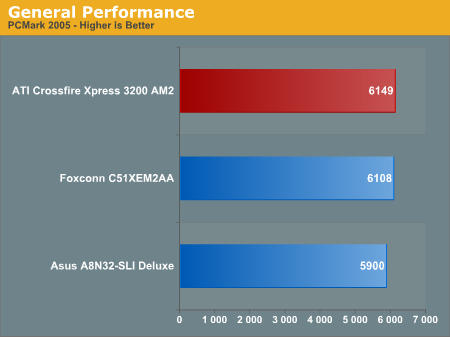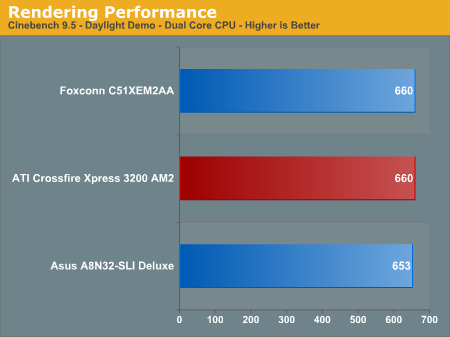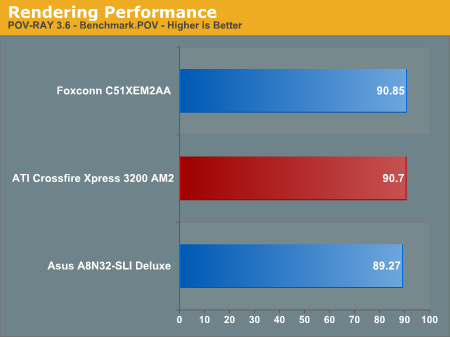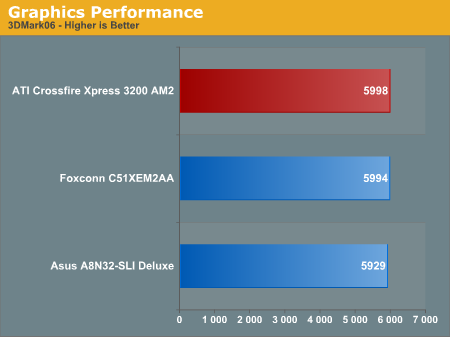CrossFire Xpress 3200: RD580 for AM2
by Wesley Fink on June 1, 2006 12:05 AM EST- Posted in
- Motherboards
General Performance
With the Memory Controller on the Athlon 64 Processor, Winstone benchmarks are no longer very revealing of motherboard performance. With the same CPU (and the same memory controller on that CPU) Winstones, both Business and Multimedia Content Creation, are tightly clustered. The only deviation from that is that boards that are tweaked for best gaming performance are often near the bottom of a tight range of benchmark performance numbers. The Winstone tests themselves are rapidly becoming dated, and are no longer supported by PC Magazine. While Winstones are still useful in providing real world performance data we are dropping Winstones from our standard motherboard test suite.

PCMark 2005 results with the ATI AM2 show the CrossFire Xpress 3200 AM2 with a 40 point lead. The nForce 590 and ATI AM2 should be considered equivalent in performance. Both show a 200+ point lead over the DDR-based Asus A8N32-SLI, consistent across both AM2 platforms.
Despite the close results in these tests, PCMark05 is proving to be a useful overall performance benchmark. It is generally more sensitive than the older Winstones and PCM04 to recent improvements in PC architecture. PCMark 05 results in general relate well to the other performance results we find in our board tests - providing a quick and reliable snapshot of board performance compared to other motherboards.



We have replaced Winstones with 2 benchmarks that use rendering to test system performance. Cinebench 9.5 and POV-RAY 3.6 benchmarks both heavily stress the CPU subsystem while performing graphics modeling and rendering. We utilize the standard benchmark demos in each program along with the default settings. Cinebench 9.5 features two different benchmarks with one test utilizing a single core and the second test showcasing the power of multiple cores in rendering the benchmark image.
Single-Core and POV-Ray results are extremely close across DDR and DDR2 platforms. However, Dual-Core Cinebench results show both NVIDIA and ATI AM2 chipsets with a larger lead over the DDR platform. Since all 3 systems were tested with a dual-core CPU at the same speed, this provides a bit of evidence that dual-core (and quad core potentially) can make better use of the extra DDR2 memory bandwidth.
3D Graphics
The 3DMark benchmarks, published by Futuremark, are probably the most widely quoted gaming performance benchmarks available. While the benchmarks are based on game sequences written by Futuremark to reveal subtle differences in gaming performance, they still have to be considered synthetic benchmarks. They are useful for broad graphics comparisons, but they are no substitute for benchmarks with real gaming engines that are currently being played.
SLI and CrossFire are also generally supported in 3DMark, but we ran 3DMark2005 and 2006 in standard mode only as we are not comparing SLI and CrossFire in this chipset review. Please take a closer look at CrossFire benchmarks later in this review for comparisons of CrossFire and SLI performance in several current games. 3DMark06 was recently introduced and you can find more in-depth information about this new 3DMark in the AnandTech article Futuremark's Latest Attempt: 3DMark06 Tested.


The 05 and 06 results both show the ATI AM2 in the lead, but the margin is small enough to be within the margin of error. Again, both AM2 boards outperform the DDR platform by several hundred points. The ATI and NVIDIA AM2 boards can be considered a dead heat in 3D Graphics performance.
Encoding
We have found encoding results are not affected by the graphics card used during the encoding benchmarks. This is demonstrated again and again by archive test results for AutoGK using an AMD 4000+ processor with a wide assortment of video cards. The performance range of those encoding tests is just 48.1 to 49.1 - a difference form high to low of just 1.0 frame. Clearly the biggest influence on this encoding benchmark is the CPU used for testing. Because encoding test results vary so little on the same standardized motherboard test platform, they have been dropped from this review and future reviews. Encoding tests are very useful in CPU testing, but they have been shown to be poor motherboard tests - particularly on the AMD platform with the memory controller on the CPU.
With the Memory Controller on the Athlon 64 Processor, Winstone benchmarks are no longer very revealing of motherboard performance. With the same CPU (and the same memory controller on that CPU) Winstones, both Business and Multimedia Content Creation, are tightly clustered. The only deviation from that is that boards that are tweaked for best gaming performance are often near the bottom of a tight range of benchmark performance numbers. The Winstone tests themselves are rapidly becoming dated, and are no longer supported by PC Magazine. While Winstones are still useful in providing real world performance data we are dropping Winstones from our standard motherboard test suite.

PCMark 2005 results with the ATI AM2 show the CrossFire Xpress 3200 AM2 with a 40 point lead. The nForce 590 and ATI AM2 should be considered equivalent in performance. Both show a 200+ point lead over the DDR-based Asus A8N32-SLI, consistent across both AM2 platforms.
Despite the close results in these tests, PCMark05 is proving to be a useful overall performance benchmark. It is generally more sensitive than the older Winstones and PCM04 to recent improvements in PC architecture. PCMark 05 results in general relate well to the other performance results we find in our board tests - providing a quick and reliable snapshot of board performance compared to other motherboards.



We have replaced Winstones with 2 benchmarks that use rendering to test system performance. Cinebench 9.5 and POV-RAY 3.6 benchmarks both heavily stress the CPU subsystem while performing graphics modeling and rendering. We utilize the standard benchmark demos in each program along with the default settings. Cinebench 9.5 features two different benchmarks with one test utilizing a single core and the second test showcasing the power of multiple cores in rendering the benchmark image.
Single-Core and POV-Ray results are extremely close across DDR and DDR2 platforms. However, Dual-Core Cinebench results show both NVIDIA and ATI AM2 chipsets with a larger lead over the DDR platform. Since all 3 systems were tested with a dual-core CPU at the same speed, this provides a bit of evidence that dual-core (and quad core potentially) can make better use of the extra DDR2 memory bandwidth.
3D Graphics
The 3DMark benchmarks, published by Futuremark, are probably the most widely quoted gaming performance benchmarks available. While the benchmarks are based on game sequences written by Futuremark to reveal subtle differences in gaming performance, they still have to be considered synthetic benchmarks. They are useful for broad graphics comparisons, but they are no substitute for benchmarks with real gaming engines that are currently being played.
SLI and CrossFire are also generally supported in 3DMark, but we ran 3DMark2005 and 2006 in standard mode only as we are not comparing SLI and CrossFire in this chipset review. Please take a closer look at CrossFire benchmarks later in this review for comparisons of CrossFire and SLI performance in several current games. 3DMark06 was recently introduced and you can find more in-depth information about this new 3DMark in the AnandTech article Futuremark's Latest Attempt: 3DMark06 Tested.


The 05 and 06 results both show the ATI AM2 in the lead, but the margin is small enough to be within the margin of error. Again, both AM2 boards outperform the DDR platform by several hundred points. The ATI and NVIDIA AM2 boards can be considered a dead heat in 3D Graphics performance.
Encoding
We have found encoding results are not affected by the graphics card used during the encoding benchmarks. This is demonstrated again and again by archive test results for AutoGK using an AMD 4000+ processor with a wide assortment of video cards. The performance range of those encoding tests is just 48.1 to 49.1 - a difference form high to low of just 1.0 frame. Clearly the biggest influence on this encoding benchmark is the CPU used for testing. Because encoding test results vary so little on the same standardized motherboard test platform, they have been dropped from this review and future reviews. Encoding tests are very useful in CPU testing, but they have been shown to be poor motherboard tests - particularly on the AMD platform with the memory controller on the CPU.










71 Comments
View All Comments
lopri - Thursday, June 1, 2006 - link
Most of responses below my post didn't read my points. I'll be paitently waiting for AT staff's responses. In the meantime, you guys can check:http://www.anandtech.com/memory/showdoc.aspx?i=267...">http://www.anandtech.com/memory/showdoc.aspx?i=267...
http://www.anandtech.com/memory/showdoc.aspx?i=239...">http://www.anandtech.com/memory/showdoc.aspx?i=239...
And the sub-reviews. If DDR400(2-2-2) are DDR600(2.5-3-3), I guess all those memory reviews on AT were wasting of time?
Ahe here is the DIMM sticks this review used for AM2 platform.
http://www.newegg.com/Product/Product.asp?Item=N82...">http://www.newegg.com/Product/Product.asp?Item=N82...
Oh that's not it. While searching, I found that decent DDR2-800 would cost >$250, and higher speed/same timing or same speed/timing sticks will (if you were to buy) dig a big hole in your packet. (think $500) Is that mainstream? What about the 1T issue??
The top of the line Socket 939 vs Socket AM2 comparison could be something like this:
2 x 512MB: DDR600 with 2.5-3-3-7 (less thanl $150) vs DDR2-800 with 3-3-3 ($500) or,
2 x 1GB: DDR500 with 2.5-3-2-7 (less than $200) vs DDR200-800 with 4-4-4 ($250)
Think about how mwny mobo/memory reviews we've seen here on AT? Why don't we use the knowledge we learned from those founding to compare Socket 939 and Socket AM2?
Spoelie - Thursday, June 1, 2006 - link
You need a reality check. Lots of reviews have pointed out that the higher cost of TCCD memory and such is not worth the little extra performance, except if you're a serious overclocker that just really wants to run his mem on 1:1 and need the frequency headroom.The common setup out there is not 270-2.5/3/2 or whatever, it is 200-2.5/3/3/8 or even CL3. Especially with the higher density memories like 1GB sticks. THAT is what most persons are running. If anything, the 2/2/2 200 are a bit too high end for the majority of people. And they're also reading AT.
lopri - Thursday, June 1, 2006 - link
What you're saying is not totally out of my context. My main meat was towards the reviewers. Does anyone here own a DDR2-800/3-3-3? (Forget about TCCD 270MHz) DO you know how much they are? Indeed, such memory is not even officially out yet. But AT is using those sticks for AM2 system but at the same time for Socket 939 system they use more "pedestrian" DDR400/2-2-2. These days you can by 2 x 1GB DDR400/2-3-2 for under $200.Wesley Fink - Thursday, June 1, 2006 - link
The Corsair 8500 we used for testing is NOT rated at DDR2-800 3-3-3 - it is actually rated at DDR2-1066 5-5-5-15. The fact is it will run at DDR2-800 3-3-3 with voltage in the 2.1 to 2.2v range. So will most other recent dimms based on Micron memory chips. At stock voltage of 1.8v it runs about 4-4-4-13.Where TCCD was capable of DDR400 2-2-2 and DDR500 2.5-2-3 or 2.5-3-3, Micron chips are currently the top-performing chips for DDR2. Infineon also has DDR2 chips that perform at lower latency and they are generally priced more reasonably.
Our memory articles ALWAYS compare performance at different memory speeds, but the fact is DDR400 was the fastest memory standard for DDR. Anything higher was overclocking. For DDR2, we have DDR2-800 as the current highest standard speed, though there will likely be a DDR2-1066 speed in the near future.
When we point out that the massive bandwidth increases in DDR2 on AM2 have almost no impact on performance, surely it is obvious that AM2 is not memory bandwidth starved. We found on DDR that the on-chip memory controller for AMD was very sensitive to latency improvements. In fact hte mad shrimp article unintentionally shows just that - gaming responded more to latency improvement than bandwidth improvement. That will also likely be the case in DDR2 EXCEPT with such a massive increase in bandwidth over DDR, latency may not matter nearly so much. We will take a closer look at htis in a future memory article.
peternelson - Thursday, June 1, 2006 - link
Price of fast, low latency DDR2 will come down once AMD users start buying it in volume. That will come, so it is not unrealistic to benchmark now using fast expensive highend memory, because it won't be as expensive or uncommon in a month or two or three when boards are in most stores and consumers are buying them in bulk eg for "back to school/college" or "Christmas holidays season" which are when sales peak. Conroe should also improve the market availability for high performance DDR2 memory.
On the other hand there are reports of far east short-term wholesale prices of ddr2 generally having a rise because of more demand.
Spoelie - Thursday, June 1, 2006 - link
http://www.madshrimps.be/?action=getarticle&ar...">http://www.madshrimps.be/?action=getarticle&ar...peternelson - Thursday, June 1, 2006 - link
AMD are moving to AM2 with or without you.
Get over it.
You will not be able to get AMD's top performing new models if you stay with 939. Ditto the 65nm processors will also be on AM2.
939 WILL be phased out sooner or later, and with it goes DDR support.
Therefore it is somewhat irrelevant question to complain about the speed of the DDR. There won't BE any DDR support going forwards. Make the transition.
lopri - Thursday, June 1, 2006 - link
Did you even read my post? What was I saying?It has nothing to do with AM2 transition and I have nothing against AM2.
peternelson - Thursday, June 1, 2006 - link
Yes, the ddr comments relate to your Q1 section, not the DDR2 discussion.
Sorry if my response seemed overly critical.
lopri - Thursday, June 1, 2006 - link
On page 3, in the tablePCIe Speeds | 100 to 2000 in 1MHz Increments